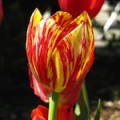- Geraniums: Two Floral Families with Striking Flowers - December 15, 2019
- Festive Flowers for a Dazzling Winter Bouquet or Centerpiece - December 14, 2019
- Forcing Flower Bulbs For the Holiday Season - December 13, 2019
The purple fall-blooming crocus is a celebrated member of the iris family. Not only does it have graceful, lavender-colored blooms, but this particular type of crocus has a treasure inside: saffron.
One corm, or bulb, produces one purple flower. Each flower has three edible, red saffron strands that are the flower’s stigmas. The threads are hand-harvested, a slow and painstaking process that accounts for the high price of the spice. The Crocus Sativus bulb does not readily self-propagate, another process that must be done by hand.
Because each flower may only bloom for a day or two, there is a sense of urgency to the harvest. While the bulbs themselves are not terribly pricey, the harvested saffron can fetch thousands of dollars per pound. It is estimated that it takes as many as 75,000 flowers to yield one pound of saffron.
Saffron has had many uses throughout its history. Native to ancient Persia, references to saffron date back thousands of years. People once believed it could cure all sorts of internal and external bodily ailments. Saffron was even considered to be a remedy for baldness.
Saffron has been used as a fabric dye since the 1200s. It yields a golden, yellow-orange hue when applied to fabric. Many Buddhists still wear robes that are referred to as saffron-colored. In fact, these robes are usually dyed with turmeric, which is much more affordable.
The most common use for saffron today is as a culinary spice. In small quantities, it is added to dishes to give them a yellow color. In larger quantities, the flavor of the saffron is the star ingredient. The taste can be difficult to describe, but it should be floral and slightly pungent or musky. Be sure to buy fresh saffron for the best flavor.
Saffron strands can be added to teas and tisanes. It is often simmered in milk with honey to make a soothing bedtime drink. It can also be steeped in cream to impart its flavor and color to custards or rice pudding. A pinch of saffron can add an exotic flavor to baked goods as well.
Perhaps the most frequent culinary use for saffron worldwide is in savory dishes. It is a key ingredient in rice dishes such as Spanish paella and many types of curry. Saffron is also an important addition to bouillabaisse, the French seafood stew. These dishes wouldn’t be the same without this essential spice.
Unlike many other bulbs, this type of crocus should be planted in spring or summer for autumn blooming. Considered low-maintenance plants, crocuses prefer rich, well-drained soil in a sunny location.
Fall-blooming crocus corms would make a considerate gift for the food-lover in your life. Left undisturbed, these perennial bulbs will return each year, yielding their precious saffron threads each autumn.
Crocus Sativus is also a thoughtful gift for someone who would love to see brilliant blooms in their fall garden. When many other plants are winding down, this late-blooming crocus is a cheerful pop of color. Whatever the occasion, the saffron crocus will surely be appreciated for the garden gem that it is.





